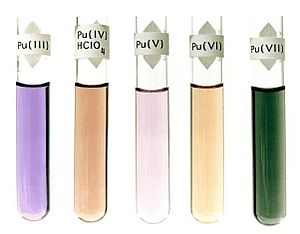Oxidation state facts for kids

The "oxidation state" (also called "oxidation number") is a super important idea in chemistry. It helps scientists understand how atoms in an element will join together to make different chemical compounds. Think of it like a score that tells you how many electrons an atom has gained, lost, or shared when it forms a bond with another atom.
Contents
Understanding Oxidation States
This concept helps us predict how atoms will behave. For example, when hydrogen and oxygen combine, they usually form H2O (water), not H3O. This is because oxygen usually has an oxidation state of −2. This means it needs two atoms with a +1 oxidation state to balance it out. Hydrogen usually has a +1 oxidation state, so two hydrogens (2 x +1 = +2) balance one oxygen (−2).
The idea of oxidation states was first used by Antoine Lavoisier. He used it to predict how oxygen would react with other things. That's why it's called "oxidation." Much later, scientists realized that when a substance is "oxidized," it actually loses electrons. So, the meaning of oxidation state was expanded to include any reaction where electrons are lost, even if oxygen isn't involved.
How Atoms Gain or Lose Electrons
You can think of oxidation states as a way to track electrons.
- For example, sodium metal has an oxidation state of 0 when it's just a pure element.
- But when it gives up its one outer electron (e−), it becomes a sodium ion (Na+). Its oxidation state changes to +1.
- Iron is another good example. It can lose two electrons, becoming an ion with an oxidation state of +2. Or it can lose three electrons, becoming an ion with an oxidation state of +3.
If elements gain electrons, they get negative oxidation states.
- If chlorine gains an electron, it forms a Cl− ion (called chloride). Its oxidation state is −1.
- If sulfur gains two electrons, it forms an S2− ion (called sulfide). Its oxidation state is −2.
These charged atoms (ions) then combine to form compounds. For example, Na+ ions and Cl− ions combine to form NaCl, which is table salt. Or Fe2+ and S2− ions combine to form FeS, which is iron sulfide.
Simple Rules for Oxidation States
There are some basic rules that help us figure out oxidation states:
- All pure, free elements (like a piece of iron or oxygen gas) have an oxidation state of 0.
- Oxygen usually has an oxidation state of −2 in most compounds. But in special compounds called peroxides (like hydrogen peroxide), it has an oxidation state of −1.
- Hydrogen usually has an oxidation state of +1 in most compounds. But when it's with very electropositive elements (like sodium), it can have an oxidation state of −1.
- Alkaline earth metals (like magnesium or calcium) always have an oxidation state of +2 in compounds.
- Alkali metals (like sodium or potassium) always have an oxidation state of +1 in compounds.
- The total of all oxidation states for all atoms in a molecule must add up to 0.
- For an ion (a charged group of atoms), the total of all oxidation states must add up to the charge of that ion.
For example, in a compound like potassium permanganate (KMnO4), the manganese (Mn) atom has an oxidation state of +7. In the CrO42− ion, the chromium (Cr) atom has an oxidation state of +6.
See also
 In Spanish: Estado de oxidación para niños
In Spanish: Estado de oxidación para niños

